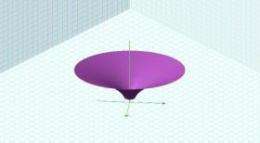May 18, 2009 weblog
Is Everything Made of Mini Black Holes?

(PhysOrg.com) -- In trying to understand how gravity behaves on the quantum scale, physicists have developed a model that has an interesting implication: mini black holes could be everywhere, and all particles might be made of various forms of black holes.
The scientists, Donald Coyne from UC Santa Cruz (now deceased) and D. C. Cheng from the Almaden Research Center near San Jose, are cautious about the idea, but say that it's worth investigating with the Large Hadron Collider (LHC) and other high energy physics experiments. Cruz and Cheng have presented their idea in a study posted on arxiv.org, "A Scenario for Strong Gravity in Particle Physics: An alternative mechanism for black holes to appear at accelerator experiments."
As the physicists explain, gravity is considered an astronomical-scale force; its effects on smaller scales seem to be virtually nonexistent. However, as the scientists write, "it has often been assumed that near the Planck scale, gravity would somehow assert itself and become comparable in strength to the other forces of nature, likely as a product of some grand unification picture." Coyne and Cheng approach the problem of small-scale gravity by presenting a new model of black hole evaporation. As black holes lose energy, they slowly evaporate, shrinking in size down to the quantum scale - where they may be identical to elementary particles.
The new model assumes "that gravity is truly strong and fully comparable with other forces, but that we have not experimentally looked in those places where it resides," the authors write. "But instead of invoking extra dimensions and branes, we look elsewhere. An obvious place where experimentalists have not tested gravity, in any way, is directly at the horizons of black holes of sufficient temperature such that quantum gravity could be operative. We speculate that at this level, the spacetime structures of the horizons could be far more complex than those predicted by general relativity. They might well require more degrees of freedom to stipulate a particular state, and they might leak information; i.e., not be true horizons in the usual sense of the word. Most important, if gravity on or within these horizons is truly strong, yet we see no evidence of that on larger scales, then the complex horizons must be shielding in nature." A shielding pseudo-horizon, they say, is an unconventional speculation, as it suggests that gravity is a very strong force but is substantially shielded.
Coyne and Cheng's "shielded strong gravity scenario" (SSGS), which is based on principles of thermodynamics and high-temperature physics, can describe black holes on all scales, but the differences in this approach manifest themselves only at Planckian and sub-Planckian black hole masses. At a critical point, the new model ceases to follow the unusual thermodynamics of the classical black hole, and instead produces a state that looks more and more like an object obeying traditional thermal physics. For instance, in the model, black hole evaporation is free of physical infinities, possesses traditional thermodynamic properties after an apparent phase change, and likely conserves information.
In other words, the model predicts that any states to be found at sub-Planckian masses will behave normally, and will be essentially identical to elementary particles. "Perhaps the most reassuring conclusion that we find is that the dynamical solution in either model forces the sub-Planckian states to obey the Heisenberg uncertainty principle, and thus allows them to act as normal fundamental particles," the scientists write.
When the physicists investigated what these mini black holes would act like, they found that the quantization of space at this scale would mean that mini black holes could turn up at a wide variety of energy levels, and in large numbers. They predict that these black holes might be so common that all particles could essentially be various forms of black holes at different energy levels.
"At first glance the scenario derived in SSGS seems bizarre, but it is not: this is exactly what would be expected if an evaporating black hole leaves a remnant consistent with quantum mechanics," Coyne and Cheng write. "One might posit that the black hole smoothly turns into something approximating a large and unstable elementary particle, which then continues to evaporate (decay) into familiar stationary states. ... This would put a whole new light on the process of evaporation of large black holes, which might then appear no different in principle from the correlated decays of elementary particles."
One of the implications of this model could be that dark energy and dark matter - which seem to act as repulsive gravity - could instead be surrounded by local concentrations of gravity-shielding black holes at the elementary particle level. Such possibilities will be difficult to investigate, however. Although it's possible that future LHC experiments could sample regions where these black holes are produced, the scientists note that this is what high-energy physics has been doing all along at other energy scales. It may not be possible to disentangle black holes from elementary particles, if there truly is no fundamental difference.
More information: D. G. Coyne and D. C. Cheng. A Scenario for Strong Gravity in Particle Physics: An alternative mechanism for black holes to appear at accelerator experiments." http://arxiv.org/ftp/arxiv/papers/0905/0905.1667.pdf
• Join PhysOrg.com on Facebook!
• Follow PhysOrg.com on Twitter!
© 2009 PhysOrg.com
















